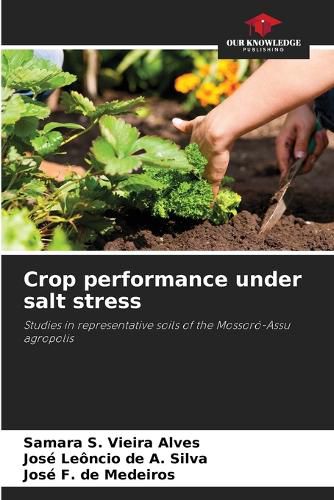Readings Newsletter
Become a Readings Member to make your shopping experience even easier.
Sign in or sign up for free!
You’re not far away from qualifying for FREE standard shipping within Australia
You’ve qualified for FREE standard shipping within Australia
The cart is loading…






The use of saline water sources in irrigation can, depending on its composition, negatively alter the physical and chemical properties of the soil and, depending on how it is applied, cause alterations in the physiological, biochemical and molecular processes of plant growth. In this context, the aim was to study the effects of irrigation with saline water (ECa) on crop performance in representative soils of the Mossoro-Assu Agropolis. The first experiment was conducted in the greenhouse of the Department of Environmental Sciences at UFERSA, Mossoro-RN, from May to June 2010, using yellow melon. The design used was entirely randomized in a 5x6 factorial scheme, with three repetitions. The factors tested were five types of soil: RQ, PVAe, CXve, RY and VX, and six levels of irrigation water salinity (0.5; 1.0; 2.0; 3.0, 4.0 and 5.0 dS m-1). The second experiment was carried out in a 2x3x5 factorial design with three replications, using two types of soil (PVAe and CXve), three levels of salinity (0.5, 2.75 and 5.0 dS m-1) and five crops: melon, beans, sorghum, corn and peppers.
$9.00 standard shipping within Australia
FREE standard shipping within Australia for orders over $100.00
Express & International shipping calculated at checkout
The use of saline water sources in irrigation can, depending on its composition, negatively alter the physical and chemical properties of the soil and, depending on how it is applied, cause alterations in the physiological, biochemical and molecular processes of plant growth. In this context, the aim was to study the effects of irrigation with saline water (ECa) on crop performance in representative soils of the Mossoro-Assu Agropolis. The first experiment was conducted in the greenhouse of the Department of Environmental Sciences at UFERSA, Mossoro-RN, from May to June 2010, using yellow melon. The design used was entirely randomized in a 5x6 factorial scheme, with three repetitions. The factors tested were five types of soil: RQ, PVAe, CXve, RY and VX, and six levels of irrigation water salinity (0.5; 1.0; 2.0; 3.0, 4.0 and 5.0 dS m-1). The second experiment was carried out in a 2x3x5 factorial design with three replications, using two types of soil (PVAe and CXve), three levels of salinity (0.5, 2.75 and 5.0 dS m-1) and five crops: melon, beans, sorghum, corn and peppers.